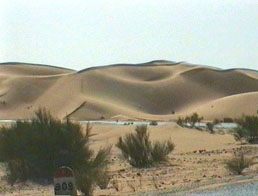
What Causes Deserts?

Background Information:
Desert landscapes are distinctive and varied. Deserts are formed by low annual rainfall, annual evaporation rate, wind, water and weathering.
Low Annual Rainfall
Deserts generally receive less than 10 inches of precipitation a year.
Annual Evaporation Rate
This is how much moisture evaporates from the surface per year. Of course this is dependent on the temperature, sunlight, and wind conditions. When the evaporation rate is higher than the annual rainfall of a specific area, that area is considered a desert- because it has a net deficit of water.
Wind
Wind is one of the prime sculptors of desert terrain. Because of the dry surfaces, the wind is able to not only to blow sand particles into high dunes, it then marches the huge sand masses across the land.
Water
Water is even a more powerful erosive force than wind. Rainfall and river flow are rare in desert areas. But when stream and river beds do get filled with water, it is carried with enormous power. This mud, sand and water move everything in its path. Believe it or not it is how the Colorado River made the Grand Canyon.
Weathering
Weathering is how exposure to the elements breaks down rocks. It's slow process but yet it contributes to desert formations.
|
Activity #3 |
|
|
Virtual Fieldtrip |
Additional Resources |
